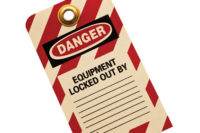In my safety management practice, it often amazes me how little it takes for someone to shift from safe mode to unsafe mode or vice versa. This means that a technique we use in one situation or with one employee might not work in another location or with another employee. Part of this appears to be because of these contextual differences. So I read all of these behavioral science studies in the hopes that I can find a few new nuggets of wisdom in each one and design more effective safety management interventions as a result.
Lessons from a grocery store
I just read a fascinating study from the marketing literature that has some very thought-provoking implications for safety. The study looked at how people feel when they get unearned preferential treatment. Customers in a grocery store were told they were selected at random to receive a free gift. The study looked at how they reacted in a variety of contexts. Since it was a marketing study, they were measuring brand perceptions and purchasing behavior. But we can apply the same ideas in safety and the use of spontaneous safety recognition. Let me explain.
The primary finding of the study was that the way people react to a reward depends on who else is in the room.
When a customer received an award when no one was watching, he was pretty good at rationalizing that it was deserved, even when it was awarded completely at random. As a result of this good feeling, the customer had a more positive attitude and interacted more with the business. You have probably experienced this yourself, telling yourself a good story to justify some special treatment that you received from a waiter or a doctor or the cable guy. After all, there is no one in the room to contradict it.
In the case of safety, this could be really effective at activating a worker’s personal safety narrative. If the safety pro gives a worker a spontaneous and unexpected reward, he feels good about the experience, has a more positive feeling toward the safety officer, and is more likely to choose the safe behavior in the future.
The self-conscious winner
But what is really interesting is what happens when there are other people in the room. When the other customers looked at the awardee favorably, none of the above process was interrupted. He still felt good about the experience and bought more. But when the other customers looked neutral, the whole narrative shifted. He felt self-conscious, had a negative experience, and bought less. I would imagine if any jealousy was visible in their body language, the effect would be even stronger.
The same thing could happen in your safety incentive program. If the safety pro gives a worker a spontaneous safety reward and co-workers look jealous, perhaps thinking that they were behaving just as safely so why didn’t they get a reward, it could backfire. The worker has a negative experience and is less likely to choose that safe behavior in the future.
Status matters
But then there is another twist. If a high status person is in the room, the experience is more likely to be positive. High status people make us feel inferior and jealous, just by being there. If something happens to make them jealous of us, it makes the experience MORE positive rather than less. This is fate evening the score.
So if you give a worker a spontaneous safety reward in front of a team leader, supervisor, or a socially popular worker, we don’t have to worry about the coworker appearing jealous, it still makes the rewardee feel good.
Culture counts
There are a few other nuances we can consider as well. National culture can change the reactions. There are some cultures that have a steep power hierarchy. This means that hierarchies are seen as natural and justified. In this case, a high status individual earned and deserves their status. Making them feel jealous of us would be a strong negative and would be counterproductive for future safety. But in a culture that has a shallow power hierarchy, where we think of the CEO as just a lucky guy who was in the right place at the right time rather than someone inherently superior to us, we are quite happy to make them jealous and feel very positive about being rewarded in front of them.
Another aspect of culture can also play a role. Some cultures put a very high value on luck. Luck is not considered a random phenomenon, but rather some supernatural power looking favorably on you. If a worker in this culture gets a spontaneous reward, it is a deserved sign from above. Others looking on would be seen more as admiration rather than jealousy, would result in a more positive experience, and could have a positive impact on future safe behavior. But in a culture where luck is considered as a random phenomenon, the jealousy would be perceived negatively and is likely to have a negative impact on future safety behavior.
Don’t lose that feeling
It shouldn’t be this complicated. It would be much simpler if we could create general rules for when to give a spontaneous safety reward and when not to. My standard advice has always been pretty straightforward. Spontaneous rewards have to be frequent enough to be noticed but not regular or they lose the feeling of spontaneity. I usually suggest about once a day and at random times so no one can expect it or plan for it. And of course you need to catch someone acting safe. Now I have to rethink the whole approach. The last thing I would want to do is make the recipient feel self-conscious now and then behave less safe in the future. A lot to think about.



